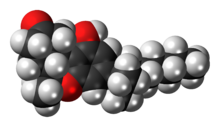Nabilone
 |
|

Top: (R,R)-(−)-nabilone,
Center: (S,S)-(+)-nabilone, Bottom: Space-filling model of (R,R)-(−)-nabilone |
|
| Clinical data | |
|---|---|
| Trade names | Cesamet, Canemes |
| AHFS/Drugs.com | Monograph |
| MedlinePlus | a607048 |
| Pregnancy category |
|
| Routes of administration |
By mouth (capsules) |
| ATC code | |
| Legal status | |
| Legal status |
|
| Pharmacokinetic data | |
| Bioavailability | 20% after first-pass by the liver |
| Protein binding | similar to THC (±97%) |
| Biological half-life | 2 hours, with metabolites around 35 hours |
| Identifiers | |
|
|
| CAS Number | |
| PubChem CID | |
| DrugBank | |
| ChemSpider | |
| UNII | |
| KEGG | |
| ChEMBL | |
| ECHA InfoCard | 100.164.824 |
| Chemical and physical data | |
| Formula | C24H36O3 |
| Molar mass | 372.541 g/mol |
| 3D model (Jmol) | |
|
|
|
|
Nabilone is a synthetic cannabinoid with therapeutic use as an antiemetic and as an adjunct analgesic for neuropathic pain. It mimics tetrahydrocannabinol (THC), the primary psychoactive compound found naturally occurring in Cannabis.
The FDA in the USA has indicated nabilone for chemotherapy-induced nausea/vomiting. In other countries, such as Canada, it is widely used as an adjunct therapy for chronic pain management. Numerous trials and case studies have demonstrated modest effectiveness for relieving fibromyalgia and multiple sclerosis.
Nabilone is a racemic mixture consisting of (S,S)-(+)- and (R,R)-(−)-isomers (cis-trans isomerism).
Nabilone is used to treat nausea and vomiting in people under chemotherapy.
Nabilone has shown modest effectiveness in relieving fibromyalgia. A 2011 systematic review of cannabinoids for chronic pain determined there was evidence of safety and modest efficacy for some conditions.
The main settings that have seen published clinical trials of nabilone include movement disorders such as parkinsonism, chronic pain, dystonia and spasticity neurological disorders, multiple sclerosis, and the nausea of cancer chemotherapy. Nabilone is also effective in the treatment of inflammatory bowel disease, especially ulcerative colitis. Medical cannabis patients report that nabilone is more similar in effect to cannabidiol (CBD) than tetrahydrocannabinol (THC), indicating that it has more of a therapeutic effect on the body than a "high" effect on the mind.
...
Wikipedia
